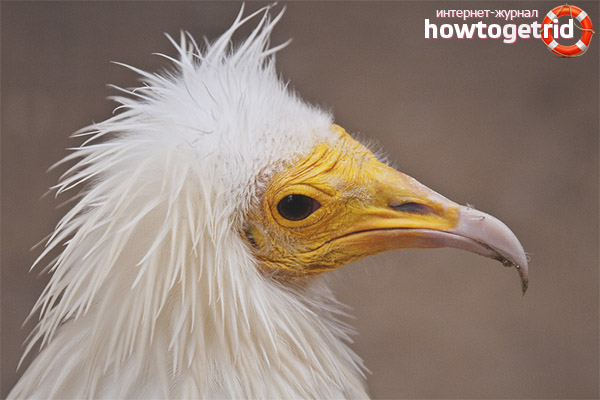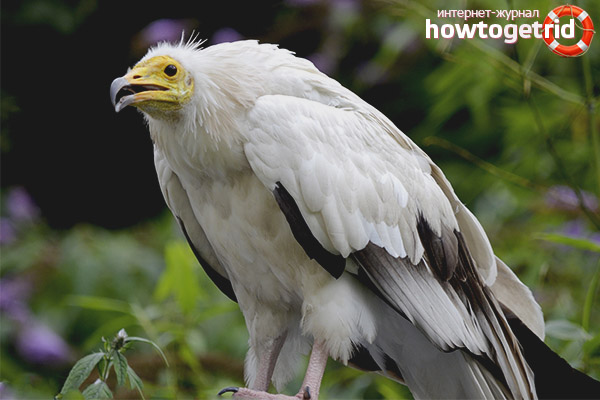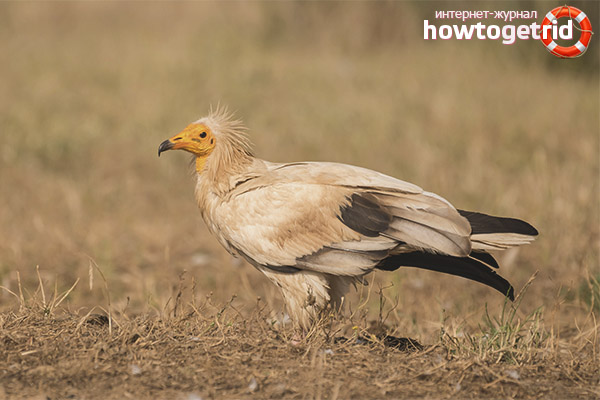The content of the article
Vultures belong to the hawk family. They are the smallest vulture representatives in Africa.
Appearance
The body of an adult is about 62-70 cm in length. Body weight ranges from one and a half to two kg. The wingspan is approximately 160 cm. The color of the plumage is white. But on the wings there are black feathers that are clearly visible when the bird soars in the sky. On the throat, the plumage is yellowish. These birds do not have feathers on their necks. In representatives of both sexes, a black stripe is visible on the face.
The plumage on the head is also absent. Yellow skin with folds is visible on it. The beak at the base is also yellow with a black tip. The color of the legs of the vulture is yellow. The tail is wedge-shaped. The thin beak of the bird at the end is bent in the form of a hook.
Young individuals are yellowish brown with spots. The plumage gradually turns white. The skin on the head is gray.
Power Features
Often vultures can eat animal feces. The litter contains carotenoids, which helps them maintain their bright yellow skin color. Often they seek food in cities where they search landfills to find suitable leftovers thrown away by humans. They are not afraid of people, so they often come close to them. In the villages and villages of Africa, this bird can be seen very often. They can sit on the roof of the house or on a tree.
In addition, vultures like to eat ostrich eggs. To break their shells, birds use large, heavy stones. They find stones in advance, and then fly to the ostrich's nest. Then they drop the stone on the egg until it breaks. If the stone is too light to break the thick shell of an ostrich egg, the bird flies away to find a heavier stone, and then returns, making new attempts. As soon as the shell breaks, they eat the germ or liquid contents.
Habitat
These birds are most common in the center and southern part of the African continent. This refers to the brown vulture. And the representatives of the species of vulture have a wider habitat. They live throughout Africa, as well as in Eurasia. Here they can be found in almost all regions characterized by a temperate climate. There are many of them in India, as well as in the Mediterranean. They live in the Canary Islands. In Russia, they are in the Caucasus. But there are very few birds left in this area. Researchers total only about 20-30 pairs.
Today, the species is considered rare. He is threatened with extinction. The populations that inhabit Europe are wintering on the African continent.
Views
There are 2 main types. In addition to the vulture common in nature, quite a few representatives of the species are brown vultures. Its body length is about 65 cm. Wings in length reach about half a meter. They weigh from one and a half to two kilograms. Outwardly very similar to ordinary. The main difference is the color of the plumage. They are completely brown. They also live in the center and in southern Africa. They live in forests, savannahs.Nests are built on trees near villages and cities. They also feed on carrion, garbage.
Gender differences
The plumage of representatives of different sexes is the same. The difference between them is only in size. Females are slightly larger than males.
Breeding and nesting
Usually vultures live in groups of several pairs, sometimes the couple lives separately from other individuals.
The mating season begins in the spring. They perform the marriage ritual in the form of a spiral flight. Nests are built on the rocks. They pile several large branches in a heap, and inside they are lined with down and wool of various animals. Sometimes they equip a nest in a cave or small hole. Some couples build a nest under the rocks to protect it from precipitation. The nests are large, but look messy. Often birds bring garbage from landfills. In the nests you can also see paper, ropes. They also do not throw out the remnants of food from the nest.
Their eggs are white with brown small specks. In one clutch, usually two eggs. Both parents take turns in hatching. After about 42 days, the chicks hatch. They appear with a difference of several days. In this case, the younger is usually weaker, and may die of hunger. Parents take care of them for 3 months. At the age of three months, they learn to fly, but another month they demand that their parents bring them food. The plumage of the chicks mirrors the coloring of adult birds.
When young individuals begin an independent life, for two years they migrate, flying away quite far from their parental nest. Only 5 years old become sexually mature.
Vote

Most of the time birds spend in pairs, but, in general, they belong to social birds. They can gather in packs around large prey or when resting. To communicate, they can make a variety of sounds. In flight, they can croak and meow. When angry, they growl or hiss.
Interesting Facts
- The name of the bird originates from the Old Slavonic language, from which the word "Strva" can be translated as "carrion". And the word Neophron is taken from the work of Metamorphosis, authored by Antonin Liberal. According to legend, the ancient god Zeus turned Egipius and Neofron on birds of prey. They were called by the same name, but they differed in their size and color of the pen.
- In ancient times, the Indian and Egyptian peoples believed that vultures are sacred birds, and therefore treated them with awe and respect. At all times, European residents treated the vulture with special disgust due to the fact that birds eat carrion.
- Often greedy and evil people are called vultures. But in fact, these birds are quite calm and non-aggressive in nature.
- Often chicks become victims of foxes or other birds of prey. Parents are not able to protect their cubs due to a rather weak beak and paws. In case the cub falls to the ground from the nest, most often it is eaten by wolves or jackals. To date, the number of species is declining more rapidly. The main reason for the threat of extinction is the destructive activity of man. Humans do not destroy them directly, but the birds suffer from interference with nature as a whole. They die when they sit on power lines, or from lead shots when they eat animals killed by guns by hunters. Together with carrion, the chemical substances used by humans enter the body of the vulture. The view is protected worldwide.
Video: Vulture (Neophron percnopterus)











Submit